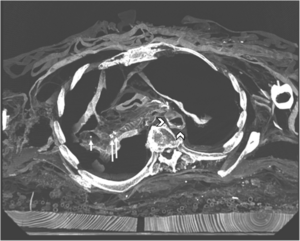Infectious Disease in the Neolithic: Difference between revisions
| Line 20: | Line 20: | ||
<br> | <br> | ||
<br> | <br> | ||
<br><br>A citation code consists of a hyperlinked reference within "ref" begin and end codes. | <br><br>A citation code consists of a hyperlinked reference within "ref" begin and end codes. | ||
==Major Pathogens== | ==Major Pathogens== | ||
Revision as of 05:26, 14 April 2024
Section

By [Author Name]
At right is a sample image insertion. It works for any image uploaded anywhere to MicrobeWiki.
The insertion code consists of:
Double brackets: [[
Filename: PHIL_1181_lores.jpg
Thumbnail status: |thumb|
Pixel size: |300px|
Placement on page: |right|
Legend/credit: Magnified 20,000X, this colorized scanning electron micrograph (SEM) depicts a grouping of methicillin resistant Staphylococcus aureus (MRSA) bacteria. Photo credit: CDC. Every image requires a link to the source.
Closed double brackets: ]]
Other examples:
Bold
Italic
Subscript: H2O
Superscript: Fe3+
A citation code consists of a hyperlinked reference within "ref" begin and end codes.
Major Pathogens
Mycobacterium tuberculosis
Genetic evidence of Mycobacterium tuberculosis, the causative agent of tuberculosis, has been found as early as 5000 years ago [1]. It is most often identified as a Mycobacterium tuberculosis complex, a larger group that is recognized by standard DNA probes [2]The complex includes M. tuberculosis, M. bovis, M. africanum, and M. microti [2]. M. tuberculosis is one of the most common causes of tuberculosis, but M. bovis and M. africanum can result in similar symptoms in humans[2]. Of these, M. bovis mostly affects cattle but can infect humans if infected meat and dairy products are ingested, while M. africanum is responsible for the majority of tuberculosis cases in Africa [2]. M. microti specifically affects mice and voles[2].
Section 2
Include some current research, with at least one figure showing data.
Section 3
Include some current research, with at least one figure showing data.
Section 4
Conclusion
References
- ↑ Fuchs, Katharina, Christoph Rinne, Clara Drummer, Alexander Immel, Ben Krause-Kyora, and Almut Nebel. “Infectious Diseases and Neolithic Transformations: Evaluating Biological and Archaeological Proxies in the German Loess Zone between 5500 and 2500 BCE.” 2019. The Holocene 29 (10): 1545–57.
- ↑ 2.0 2.1 2.2 2.3 2.4 Rothschild, Bruce M., Larry D. Martin, Galit Lev, Helen Bercovier, Gila Kahila Bar‐Gal, Charles Greenblatt, Helen Donoghue, Mark Spigelman, and David Brittain. “Mycobacterium Tuberculosis Complex DNA from an Extinct Bison Dated 17,000 Years before the Present.” 2001. Clinical Infectious Diseases 33 (3): 305–11.
Authored for BIOL 238 Microbiology, taught by Joan Slonczewski,at Kenyon College,2024
